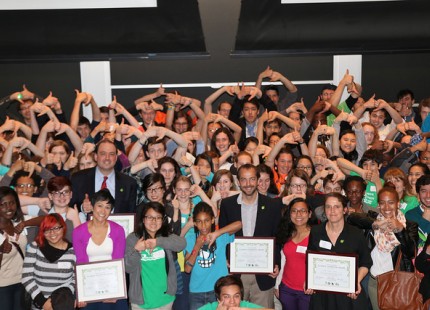Climate Summit
Organizing a climate summit for your school, community, or region is a great way to educate people about many issues related to climate change at once, or dive deep into one topic you really care about. Depending how big you make your event and how many people you invite, summits can be a lot of work, but they are also tons of fun!

PROJECT STEPS:
STEP 1: Get educated
Learn what aspects of climate change most impact your community, what solutions are happening locally, and what people are most interested in learning. Consider doing a short survey of your classmates to learn what they care most about. We always encourage summits to be focused on solutions, as well as building an understanding of the problem, so folks leave feeling hopeful and know how they can take action. Themes might include:
- health issues, like asthma rate from local coal-fired power plant,
- extreme weather like severe storms or drought
- energy efficiency and renewable energy
- action at different scales from individual action (like DOTs), community projects (like recycling or school gardens), or larger-scale policy changes (like renewable energy policy)
STEP 2: Decide on the logistics
- The date
- Location
- Time
- Length of summit
- Who you should talk to for support (students, teachers, staff, parents, neighbor schools, etc)
STEP 3: Develop an agenda for the day
Think back to some of the most enjoyable conferences, events, or trainings you’ve attended. What were some key elements to the day? What did you learn? How would you have changed or tweaked it to make it more effective?
- If you did a survey to see what students at your school are interested in learning about, design your agenda around your results, covering topics your school cares about. Present a climate problem everyone knows about, like paying for recycling programs, and steer the conversation toward finding solutions.
- Set an end goal of the day. What do you want people to do as a result of the summit? Be sure to include time for introductions and a wrap-up and leave time for breaks.
- Finally, we recommend incorporating a mix of keynotes, panels, and workshops:
- Keynotes are broad speeches delivered by one expert or leader;
- Panels are focused discussions with several experts, usually led by a moderator;
- Workshops engage the audience in finding specific solutions, usually through a mix of exercises and/or lessons;

STEP 4: Get support and approval
If you are going to host an event at your school, you need to get approval from your principal. Explain to your administration why this event is important and make a clear request for ways that you need support, like space for the event, janitorial services, food, etc.
TIP: Prepare for this meeting. This is a crucial step in your project. Have a clear outline of what you want to discuss during this meeting, including important findings from your research, project goals and milestones in your timeline.
STEP 5: Create a planning timeline and assign roles
What are all the steps along the way? Who will do them? When it comes to event planning, details are critical. Here are some things to consider:
- Will you offer food or drinks?
- Who are potential speakers, workshop leaders, and exhibitors?
- Will you need a projector screen, projector, microphone, tables, chairs?
- Do you need money to support the event? (Hint: ask local businesses to sponsor the summit.)
- What information do you need to advertise for the events? How will people register?
- What will need to be done the day before the event? How about the day of the event?
- How can you get local media to come and cover the event?
- How will you thank your participants and leaders after the event?
STEP 6: Invite potential speakers, workshop leaders, and exhibitors
This could include students, teachers, administrators, parents, professors from a local university, and/or educators from other organizations. People are busy. Invite your speakers and leaders at least one month before your event. Some might not be available, so make sure you have a back-up plan if someone says “no.”
STEP 7: Make a list of potential attendees
This could include students, teachers, administrators, school district representatives, ACE Action Teams from neighboring schools, local elected officials, local business leaders, and more. Some things to consider:
- How will you invite them?
- How will they register for the summit?
- What information will they need about the day?
STEP 8: Get the buzz going
Here are some ideas to get people talking about your event and ways to invite people:
- Put posters up, make morning announcements, and write an article in your school newspaper about the summit.
- Send announcements to local businesses and neighboring schools.
- Ask teachers to promote in class (maybe they can even provide extra credit as a reward for attending).
- Post info on social media (Facebook, Instagram, etc).
- Text and email your friends about the summit.
STEP 9: Hold the summit
Be sure to document your experience. Take a ton of pictures and have a plan for how to get them off of everyone’s cameras after the event. Collect stories from participants about how the day is going for them. You could use these to write an article for the school’s paper or to share out on social media. If you have someone on your team who is good at video editing, film the event and create a video to share your success on your school’s website or on social media.
STEP 10: Share your results
What came out of the summit? Are you proposing ideas or policy changes to your school, city or district? Let the world know what happened at the event through articles in the school and town newspaper, blog posts, Facebook and other online media, and even school-wide announcements. This is where all those photos, stories, and videos of the day will really come in handy.
STEP 11: Give thanks
Send thank you emails and notes to participants and all your speakers, workshop leaders, and exhibitors. Thank your Action Team members, adviser, principal, all the people who made the day possible. People like to be noticed for the time and effort that they give.
STEP 12: Tell ACE
Send pictures from the summit to [email protected]. We’ll give you a shout out on our social media sites. Also, let us know if you’d like to write a blog to share your success with ACE’s network.
Want more ideas?
For lots of additional resources and tips, check out this excellent Youth Climate Summit Toolkit from our friends at the Wild Center in New York.
